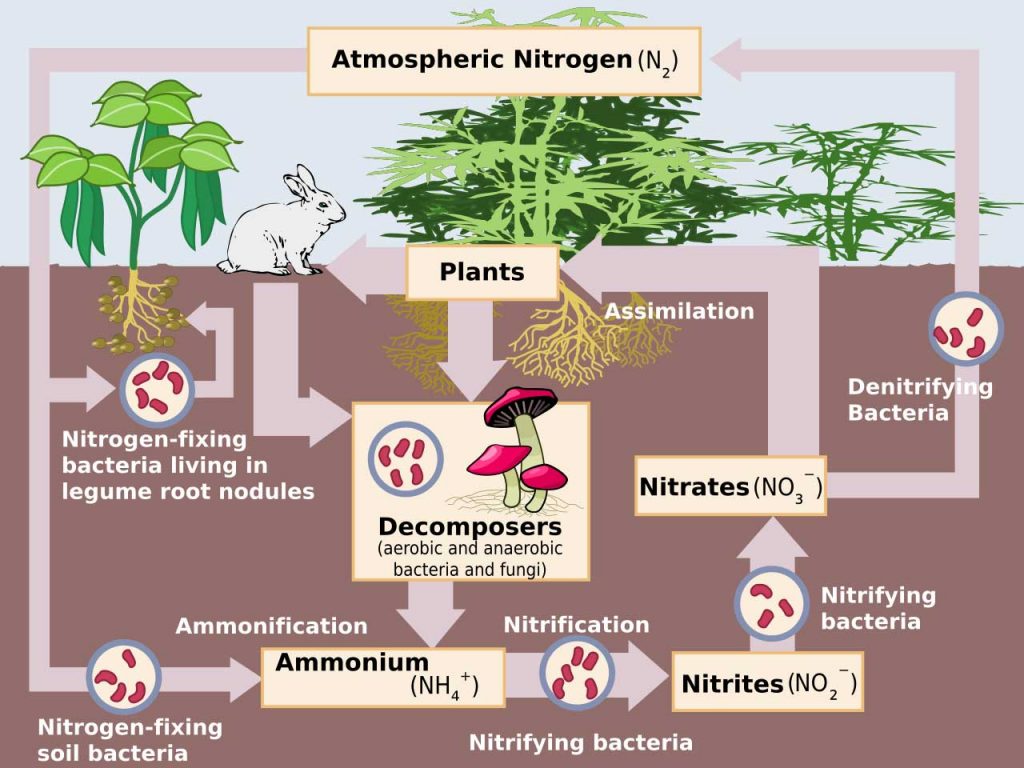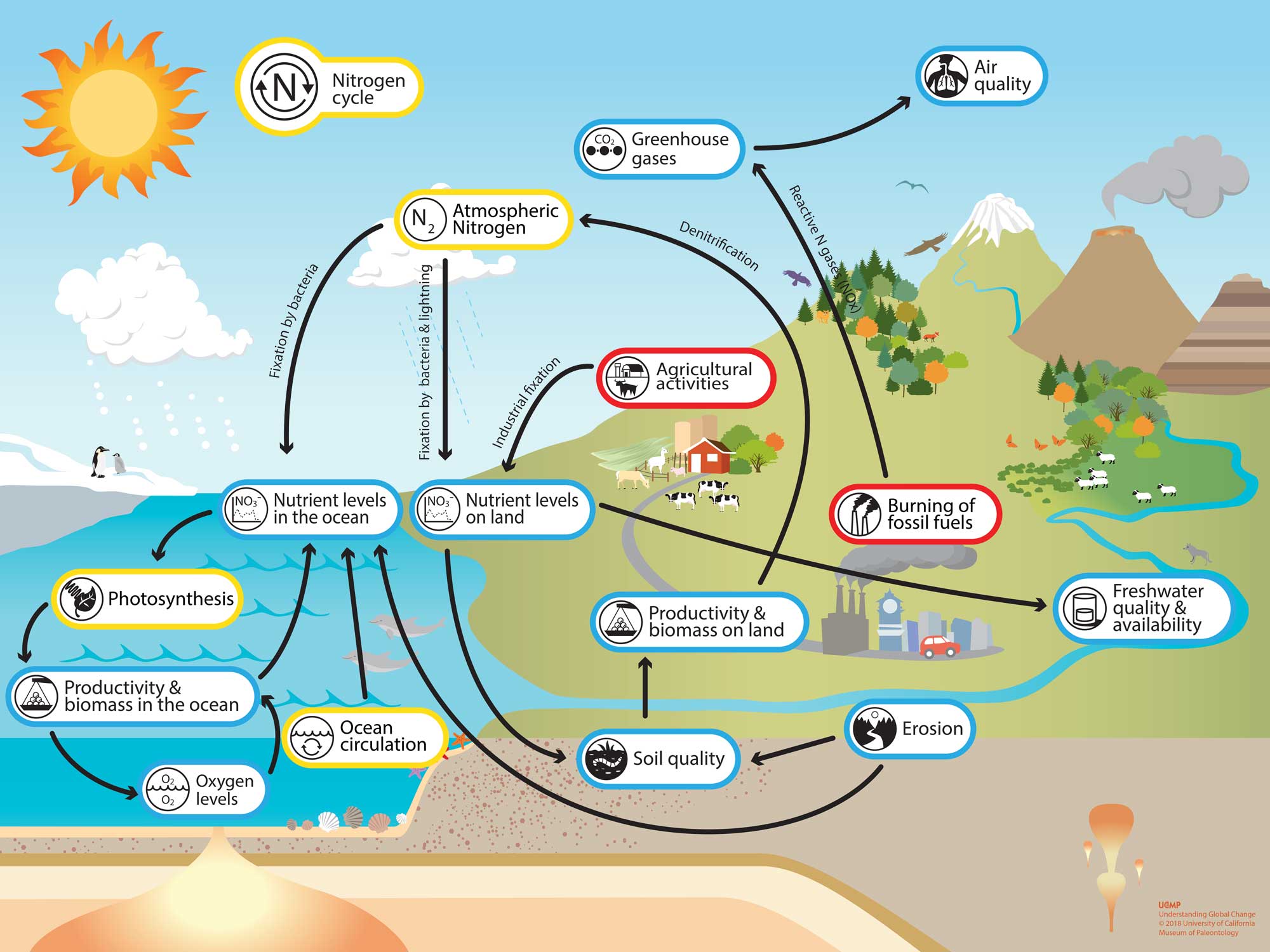Once In Plants And Animals, Explain How Does Nitrogen Return To The Atmosphere?

The nitrogen cycle refers to the movement of nitrogen within and between the atmosphere, biosphere, hydrosphere and geosphere. The nitrogen cycle matters because nitrogen is an essential food for sustaining life on Globe. Nitrogen is a cadre component of amino acids, which are the building blocks of proteins, and of nucleic acids, which are the building blocks of genetic material (RNA and DNA). When other resources such as light and water are arable, ecosystem productivity and biomass is often limited by the corporeality of available nitrogen. This is the primary reason why nitrogen is an essential function of fertilizers used to raise soil quality for agronomical activities.
What is the nitrogen bicycle?
Nitrogen cycles through both the abiotic and biotic parts of the Earth system. The largest reservoir of nitrogen is found in the atmosphere, mostly as nitrogen gas (N2). Nitrogen gas makes up 78% of the air we breathe. Most nitrogen enters ecosystems via certain kinds of bacteria in soil and plant roots that convert nitrogen gas into ammonia (NHthree). This process is called nitrogen fixation. A very minor amount of nitrogen is stock-still via lightning interacting with the air. One time nitrogen is fixed, other types of bacteria convert ammonia to nitrate (NOiii ‑) and nitrite (NO2 –), which can then be used by other bacteria and plants. Consumers (herbivores and predators) get nitrogen compounds from the plants and animals they swallow. Nitrogen returns to the soil when organisms release waste or dice and are decomposed past bacteria and fungi. Nitrogen is released dorsum to the atmosphere by bacteria get their energy by breaking downwards nitrate and nitrite into nitrogen gas (also called denitrification).

A simplified diagram showing terrestrial nitrogen cycling. Credit: Wikimedia
Nitrogen levels tin can vary significantly in aquatic and terrestrial habitats, and can be affected by various human activities and ecology phenomena, including:
- The production and use of fertilizers for agricultural activities that increase the corporeality of nutrients in soil or h2o, peculiarly nitrogen (and phosphorus). These nutrients increase plant and algae growth. Yet, increased food is non always a proficient thing. For case, in aquatic environments food-rich runoff (erosion) tin crusade large numbers of algae to grow. When these algae die they are consumed past bacteria which tin can reduce oxygen levels in the water, killing fish and other species. This process is known as eutrophication.
- The abundance (biomass) and biodiversity of bacteria, plants, fungi species that can fix nitrogen. Certain species of agronomical crops, including legumes (plants in the edible bean family) such as soy, clover, and peas, besides host symbiotic nitrogen-fixing leaner in their roots. As humans increment nitrogen soil levels, this can also reduce populations of plant species that are adapted to low-nitrogen soils.
- The burning of fossil fuels releases nitrous oxide (NiiO), a greenhouse gas, into the temper. The called-for of fossil fuels as well releases nitrogen oxides (NOx), sulfur dioxide (SO2), and carbon dioxide (CO2) that react with water vapor, oxygen, and other chemicals to grade acid rain. Acid rain can touch freshwater sources, where increased nutrients can upshot in harmful algal blooms that reduce water oxygen levels and harm fish populations and other wild animals. Additionally, acid rain increases chemical weathering of rocks, including manmade structures.
- Increased precipitation can increase erosion and thus increase the transport of nitrogen (and other chemical nutrients) into soils, freshwater environments, and littoral waters.
- Deforestation, habitat loss, and erosion tin can reduce the nutrient levels in soils. The process of producing fertilizers besides introduces pollutants into the environment which alters habitats.
- Changes in ocean apportionment patterns can alter the concentration and distribution of nutrients that are transported offshore. Dissolved chemical nutrients, especially nitrogen (and phosphorus) are critical for marine organisms, including the growth of plankton and algae which form the base of about ocean food webs. When organisms dice they sink to the bottom of the ocean where their nutrients are released equally they decay. These nutrients can exist returned to the surface by ascending currents through a process known as upwelling, which is caused by offshore winds. Regions with coastal upwelling have highly productive ecosystems because of the nutrient rich upwelled water.
- Changes in atmospheric circulation patterns can alter the concentration and distribution of dust (airborne particles) that incorporate nitrogen (and other nutrients) for life on land and in aquatic environments.
Earth system model well-nigh the nitrogen cycle
The Globe system model below includes some of the processes and phenomena related to the nitrogen cycle. These processes operate at diverse rates and on dissimilar spatial and temporal scales. For example, fixation of nitrogen past leaner happens on small spatial scales, but human apply of fertilizers tin can touch entire ecosystems. Can you remember of additional cause and event relationships betwixt the parts of the nitrogen bike and other processes in the Earth arrangement?

Explore the Earth System
Click the linked bolded terms (e.g. agronomical activities, productivity and biomass, and nutrient level) on this page to learn more than about these process and phenomena. Alternatively, explore the Understanding Global Change Infographic and find new topics that are of involvement and/or locally relevant to you.
Links to Larn More
- Nature Education: The Nitrogen Bicycle: Processes, Players, and Human Touch
- Nature Education: Biological Nitrogen Fixation
- Ecological Social club of America: Homo Amending of the Global Nitrogen Cycle: Causes and Consequences
- EPA: Nutrient Pollution
Source: https://ugc.berkeley.edu/background-content/nitrogen/
Posted by: mercierwhitu1954.blogspot.com

0 Response to "Once In Plants And Animals, Explain How Does Nitrogen Return To The Atmosphere?"
Post a Comment